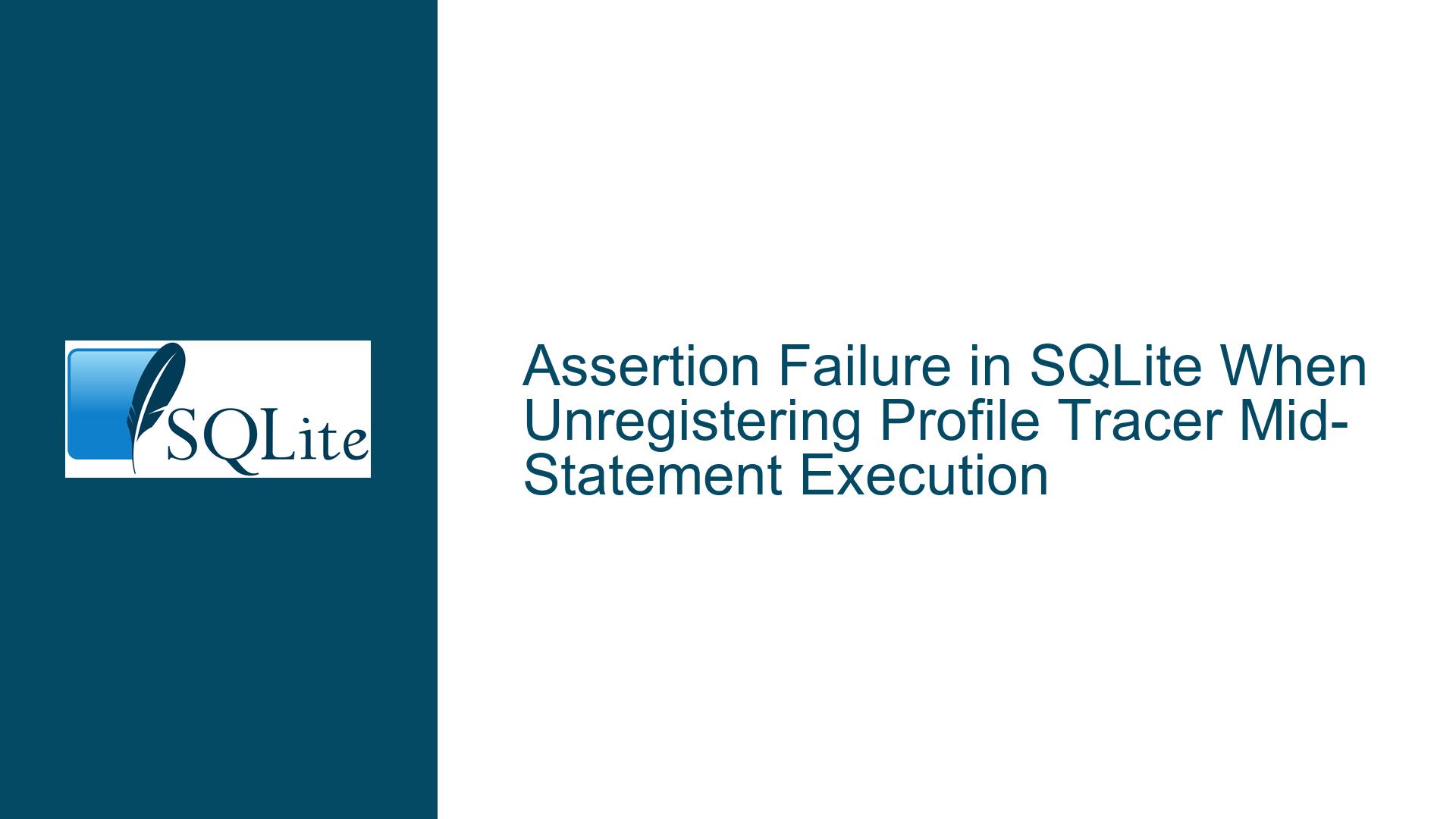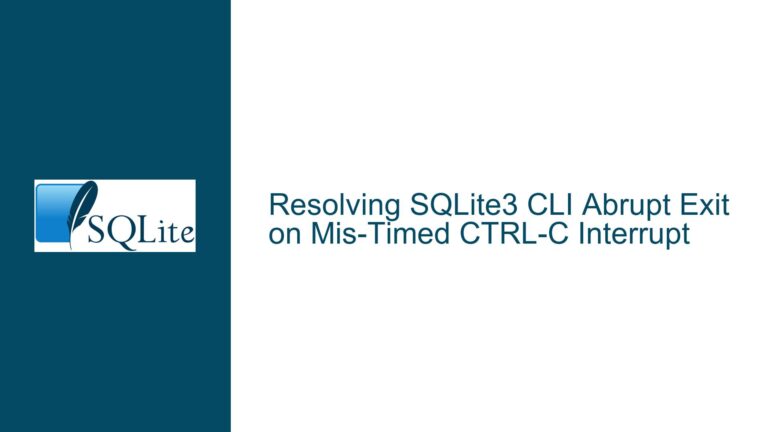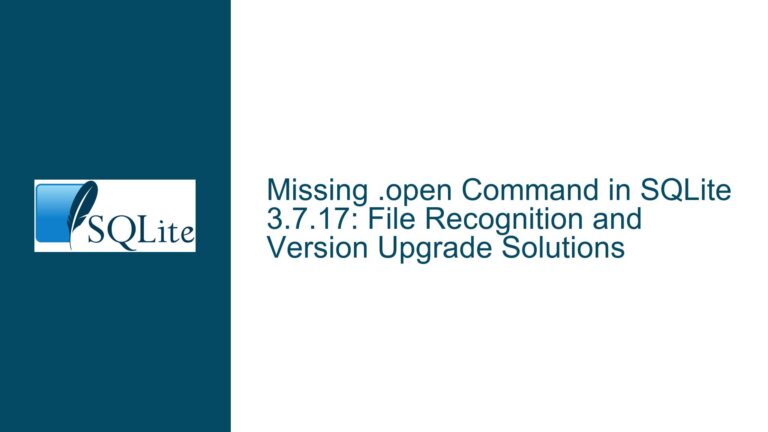Assertion Failure in SQLite When Unregistering Profile Tracer Mid-Statement Execution
Issue Overview: Assertion Failure Due to Unregistered Profile Tracer During Statement Execution
The core issue revolves around an assertion failure in SQLite when a profile tracer, specifically one registered with SQLITE_TRACE_PROFILE, is unregistered mid-statement execution. This scenario occurs when a statement begins execution with a registered tracer, but the tracer is unregistered before the statement completes. The assertion failure is triggered in the invokeProfileCallback function, which expects the tracer to still be active when the statement finishes. The assertion checks whether the db->mTrace flag still has the SQLITE_TRACE_PROFILE or SQLITE_TRACE_XPROFILE bits set, but fails because the tracer has already been unregistered.
The assertion failure itself is not catastrophic—it does not result in data corruption or other harmful side effects. However, it does indicate an untested code path in SQLite, which can disrupt applications relying on profile tracing for performance monitoring or debugging. The issue is particularly problematic for applications that dynamically register and unregister tracers during runtime, as it can lead to unexpected crashes or test failures.
The specific assertion failure occurs in the invokeProfileCallback function at line 90633 of the SQLite amalgamation source code (version 3.48.0). The assertion checks the condition (db->mTrace & (SQLITE_TRACE_PROFILE|SQLITE_TRACE_XPROFILE)) != 0, which fails because the db->mTrace flag no longer includes the SQLITE_TRACE_PROFILE or SQLITE_TRACE_XPROFILE bits after the tracer is unregistered. This suggests that the assertion is overly strict and does not account for the possibility of the tracer being unregistered mid-statement execution.
Possible Causes: Misalignment Between Tracer State and Statement Execution Lifecycle
The root cause of this issue lies in the misalignment between the lifecycle of a registered tracer and the lifecycle of a statement being executed. When a tracer is registered using sqlite3_trace_v2 or sqlite3_profile, SQLite initializes certain internal state variables, such as startTime, to track the execution time of statements. These state variables are used by the invokeProfileCallback function to provide profiling information when the statement completes.
However, the current implementation does not account for the possibility of the tracer being unregistered while a statement is still executing. When the tracer is unregistered, SQLite clears the db->mTrace flag, which removes the SQLITE_TRACE_PROFILE and SQLITE_TRACE_XPROFILE bits. This action effectively disables the profiling mechanism for any ongoing statements. When the statement eventually completes, the invokeProfileCallback function is called, but the assertion fails because the db->mTrace flag no longer indicates that profiling is active.
Another contributing factor is the lack of synchronization between the tracer unregistration process and the statement execution process. SQLite does not enforce any locking or synchronization mechanisms to ensure that a tracer remains registered for the entire duration of a statement’s execution. This lack of synchronization allows the tracer to be unregistered at any point, even while a statement is actively being executed.
Additionally, the assertion itself may be overly strict. The assertion checks whether the db->mTrace flag includes the SQLITE_TRACE_PROFILE or SQLITE_TRACE_XPROFILE bits, but it does not verify whether the corresponding callback functions (db->trace.xV2 or db->xProfile) are still valid. This means that even if the tracer has been unregistered, the assertion could still pass if the db->mTrace flag were not cleared properly. However, in the current implementation, the flag is cleared when the tracer is unregistered, leading to the assertion failure.
Troubleshooting Steps, Solutions & Fixes: Addressing the Assertion Failure and Improving Tracer Management
To resolve this issue, several approaches can be taken, ranging from immediate workarounds to long-term fixes in the SQLite codebase. Each approach addresses different aspects of the problem, including the assertion failure, the misalignment between tracer state and statement execution, and the lack of synchronization.
Immediate Workaround: Avoid Unregistering Tracers Mid-Statement Execution
The simplest workaround is to avoid unregistering tracers while statements are still executing. This can be achieved by ensuring that all statements have completed before unregistering the tracer. For example, applications can use sqlite3_finalize to finalize all prepared statements before calling sqlite3_trace_v2 with a null callback to unregister the tracer. This approach ensures that no statements are left in an intermediate state when the tracer is unregistered, preventing the assertion failure.
However, this workaround may not be feasible for all applications, particularly those that require dynamic tracer management. In such cases, additional measures may be necessary to handle the assertion failure gracefully.
Modify the Assertion to Account for Unregistered Tracers
A more robust solution is to modify the assertion in the invokeProfileCallback function to account for the possibility of the tracer being unregistered mid-statement execution. Instead of checking the db->mTrace flag, the assertion could verify whether the callback functions (db->trace.xV2 or db->xProfile) are still valid. This approach would allow the assertion to pass even if the tracer has been unregistered, as long as the callback functions are still present.
For example, the assertion could be modified as follows:
assert(db->trace.xV2 != NULL || db->xProfile != NULL);
This modified assertion ensures that the callback functions are still valid before proceeding with the profiling logic, regardless of the state of the db->mTrace flag.
Implement Synchronization Mechanisms for Tracer Management
To address the lack of synchronization between tracer unregistration and statement execution, SQLite could implement additional locking or synchronization mechanisms. These mechanisms would ensure that a tracer cannot be unregistered while a statement is still executing. For example, SQLite could introduce a new mutex or lock specifically for managing tracer registration and unregistration. This lock would be acquired before unregistering a tracer and released after all statements have completed.
While this approach would add some overhead to the tracer management process, it would provide a more robust solution to the problem. It would also prevent other potential issues related to concurrent tracer management and statement execution.
Enhance the Tracer Lifecycle Management
Another long-term solution is to enhance the lifecycle management of tracers in SQLite. This could involve introducing new APIs or extending existing ones to provide more control over tracer registration and unregistration. For example, SQLite could introduce a new function that allows applications to explicitly indicate when a tracer should be unregistered, ensuring that all statements have completed before the tracer is removed.
Additionally, SQLite could introduce new flags or options to control the behavior of tracers during statement execution. For example, a new flag could be introduced to indicate whether a tracer should remain active for the entire duration of a statement’s execution, even if it is unregistered mid-statement. This would provide applications with more flexibility in managing tracers while avoiding assertion failures.
Testing and Validation
Finally, it is essential to thoroughly test and validate any changes made to address this issue. This includes adding new test cases to the SQLite test suite to cover scenarios where tracers are unregistered mid-statement execution. These test cases should verify that the assertion failure no longer occurs and that the profiling logic behaves as expected in all scenarios.
In addition to automated tests, manual testing should be conducted to ensure that the changes do not introduce any regressions or new issues. This includes testing the changes in real-world applications that rely on dynamic tracer management to ensure that they continue to function correctly.
Conclusion
The assertion failure in SQLite when unregistering a profile tracer mid-statement execution is a nuanced issue that highlights the complexities of managing tracers in a dynamic environment. By understanding the root causes of the issue and exploring various solutions, developers can address the problem effectively and ensure that their applications continue to function reliably. Whether through immediate workarounds, code modifications, or long-term enhancements to SQLite’s tracer management, there are multiple paths to resolving this issue and improving the robustness of SQLite-based applications.






